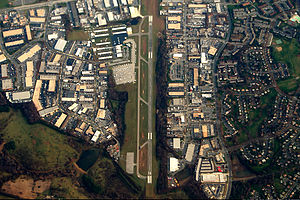What can be done to meet the present and future needs of Montgomery County citizens and businesses for air transportation?
We’re in the second decade of the 21st century. Aviation is not a recent discovery. In the modern era, folks get from point A to point B by airplane. Is there any future for air transportation in Montgomery County, Maryland? Or is the concept of “Montgomery County” and “airplane” an oxymoron?
In early December, a two-engine jet plane crashed short of the runway at Montgomery County Airpark, about three miles northeast of Gaithersburg. It was a foreseeable and preventable tragedy. Three people were killed on the ground — a mother and two children inside their home — and in the airplane, the pilot and two passengers perished. Six dead total. (Washington Post story)
The Montgomery County Airpark (GAI) is a public use general aviation airport operating 24-7. FAA technical information about Montgomery County Airpark is here.
The following summary is from the Airpark web page, where much additional detailed information can be found.
“Montgomery County Airpark presently hosts approximately 100,000 operations yearly and is considered to be the fourth busiest Maryland general aviation public use airport. We base over 200 aircraft of all types – from sleek modern jets to Piper Cubs. About 15% of all traffic is of the commercial type or Part 135 air taxi consisting of a variety of modern-day aircraft such as Cessna Citations, Lear Jet, Beechcraft (both jet and turbine), and Falcon Jet. We also are home to a Part 135 air taxi firm that specializes in transporting air travelers to various destinations in the east coast and the mid-west on a regular “on demand” basis.
Our 4,200 foot runway, which has three instrument approaches, makes us the closest “jetport” to the Nation’s Capital.”
I remember visiting the Montgomery County Airpark as a teenager, shortly after it opened in 1960. I remember many single-engine propeller planes, mostly very small planes with the wing above the cockpit and fixed landing gear. I may have seen a small two-engine propeller plane. I think most of the planes were two-seaters. I doubt if any could accommodate more than four people. The airport was way out in the boondocks of northern Montgomery County. That’s the way it seemed to a kid from Wheaton Woods.
Let the record show that the Montgomery County Airpark was not then and is not now within the Gaithersburg town limits. Gaithersburg was a small town in 1960; now it’s a small city with high-tech businesses. The airport was once surrounded mostly by farmland. A wayward single-engine plane could hardly miss the runway; but even if one did, the most damage it could do was to mow a few rows of corn. As The Washington Post noted, the once-isolated airport has become surrounded by suburban sprawl in the half-century since it was built.
The private plane approaching the runway this month was a two-engine jet. The pilot was a 66-year-old executive from North Carolina, not a professional pilot, but a well-qualified and experienced pilot nevertheless.
In May, I wrote a long essay, published in The Seventh State blog, about Montgomery County as a so-called “economic engine.” Toward the end of that long article, I pointed out that MoCo is a jurisdiction of 1 million people without a major airport. I was thinking of ordinary air travelers, who depend on airlines flying out of Baltimore-Washington International and Dulles International.
The Montgomery County Airpark has now come under intense scrutiny. Is it adequate to safely handle corporate jets, charter flights, air taxi services, and other types of general aviation? Does the 4,200-foot runway need to be lengthened or improved? I’ll leave those questions for the experts, of course.
If it became necessary to limit flights at the MoCo Airpark, how would that affect local economic development? Other general aviation facilities are the Carroll County Regional Airport (5,100-foot runway), on Rt. 97, three miles north of Westminster; and the Frederick Municipal Airport, (two runways, 5,219-foot and 3,600-foot) near the I-70 and I-270 interchange.
The more I think about transportation infrastructure for the 21st century, the more complicated it gets. And it’s all interrelated. One of the benefits of the Intercounty Connector is that it brings BWI closer to Montgomery County. By the same token, a new Potomac River bridge linking MoCo to Virginia would bring Dulles closer. It’s all infrastructure, and it’s all expensive. Just thinking.
— John Hayden
What do you think about access to air travel in MoCo?



The airpark has been surrounded by residential areas for at least two decades. In the last few years the traffic at the airpark has increased significantly, partly by an increase in student flights. Noise and almost continuous overflights have become a concern to long time residents. There is really no significant governmental unit overseeing the operation of the airpark, the FAA having no apparent interest, the state having no jurisdiction, and the county only interested in the financial aspects of operations. It would be great if a better location for a western Maryland regional airport could be found and the airpark scaled back.
LikeLike